MICHELLE: The long-awaited return of Sailor Moon has inspired us to devote this month’s column to classic shoujo art, focusing on a celebration of its sheer prettiness. Normally, we try to be astute in these columns—their whole purpose is to provide experience in seriously considering the artistic merits of manga—but it’s possible that this time we’ll be reduced to just sighing happily.
MJ: Yes, it’s quite possible indeed. But honestly, I think that’s valuable in its own way, and maybe we’ll end up learning a little something about why these things make us sigh happily.
MICHELLE: Perhaps so!
So, for my contribution I’ve chosen two memorable moments from the first volume of Naoko Takeuchi’s Pretty Guardian Sailor Moon. The first one comes from a chapter in which the protagonist, Usagi Tsukino, has infiltrated a masquerade ball in an effort to determine whether the Legendary Silver Crystal might be found there. Possible foe/possible ally Tuxedo Mask is also on the crystal’s trail, but pauses to give Usagi a twirl on the dance floor.
Pretty Guardian Sailor Moon, Volume 1, Chapter 4, Pages 142-143 (Kodansha Comics)
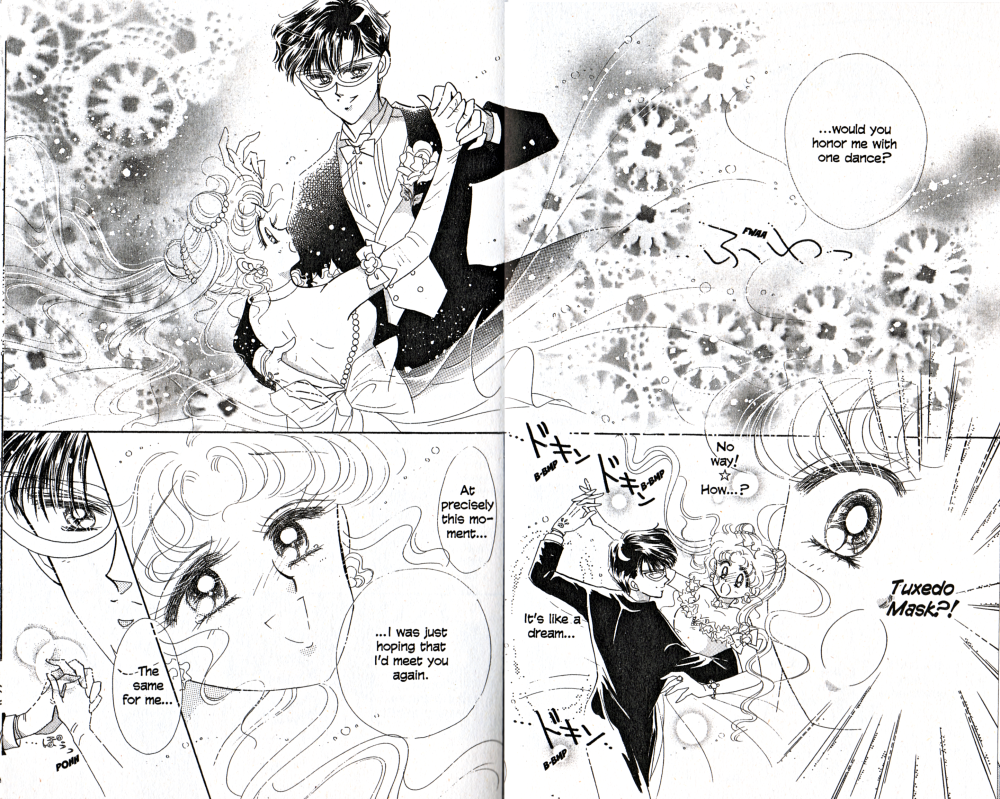
Takeuchi’s art perfectly captures the sheer dreaminess of this encounter for Usagi. In the top panel, the lacy screentone mimics the flare of her skirts, and the way that the smaller panels are framed focuses attention on facial expressions and reinforces the feeling that no one and nothing is capable of intruding upon this perfect moment for them.
And, of course, her dress is purty.
MJ: This sequence truly is dreamy. What particularly pulls me in here is the screentone. Its texture brings a 3D quality into this 2D world, as though the moment was preserved and wrapped up in an elaborate scrapbook that I could reach out and touch—as though it was someone’s real memories of the moment. Even just looking at something that has such a familiar texture stimulates my sense of touch, bringing me more fully into the scene. I think this kind of tangible decoration not only lends a fairy-tale dreaminess to the scene, but also makes it feel more personal for the reader.
MICHELLE: Ooh, you’re right, it does feel like a page from a scrapbook! In that sense, the screentone almost seems like it represents a snippet of the actual material of Usagi’s dress.
In addition, Usagi has used her transformation gadget for this chapter and is supposed to appear a little older than usual. I think her expression on the lower left page captures that subtle distinction nicely.
MJ: I’ll note too, that while this particular brand of big-eyed shoujo tends to get a lot of flack outside shoujo fandom, that it’s Usagi’s big, shining eyes that really let us know how she feels here, and just how dreamy this moment really is for her (and subsequently for us).
MICHELLE: You know, I think I’ve become inured to the big-eyed thing, except with extreme cases, because I don’t even notice it anymore. It just seems like such an obvious way to convey youth and wonder.
My second “memorable moment” is an example of a Sailor Moon action sequence.
Pretty Guardian Sailor Moon, Volume 1, Chapter 5, Pages 188-189 (Kodansha Comics)
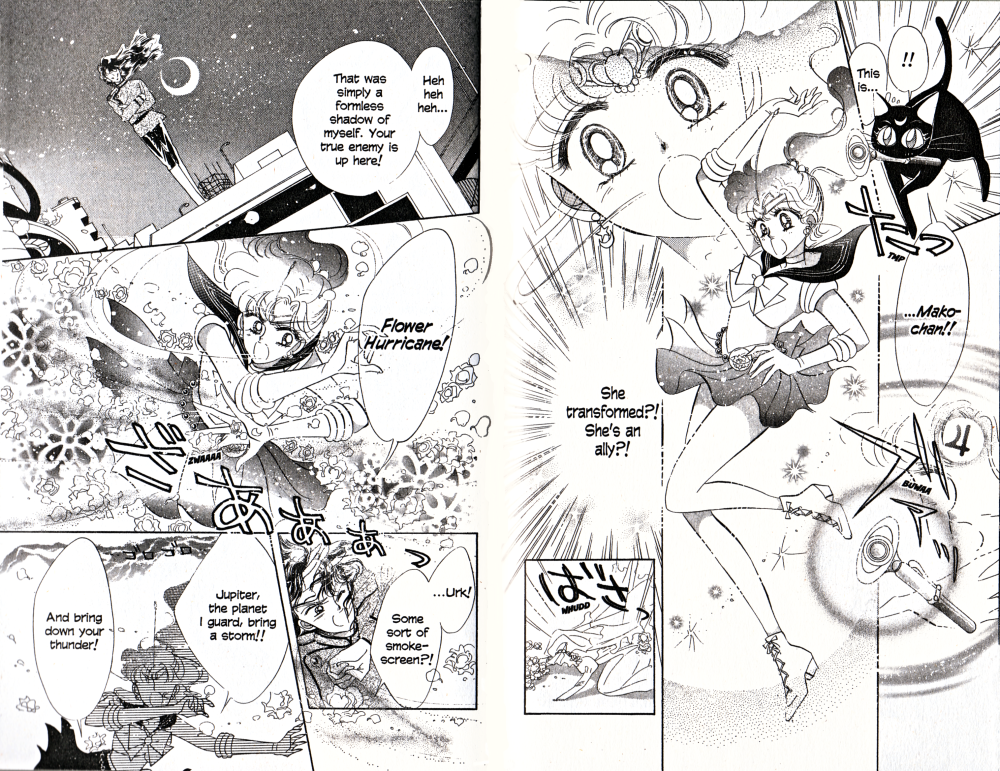
In its way, this selection is just as pretty as the other one. Luna tosses Makoto her transformation pen, which glows in an appealingly magical girl fashion, transforming the girl—who is somewhat insecure about her physique—into Sailor Jupiter, someone both beautiful and powerful. Meanwhile, the enemy lurks on a nearby rooftop, and I’m impressed how this single panel so effectively establishes setting and atmosphere when one doesn’t have the preceding pages to furnish that information. Makoto’s first attack is simultaneously feminine and effective, giving her the opportunity to vanquish the enemy with her thunder bolt on the next page.
Looking back at some of the adjectives used in the paragraph above, I find that they aptly convey what it is I like about this moment: beauty and power, femininity and effectiveness. Sailor Moon shows that these things need not be mutually exclusive.
MJ: Those are great adjectives, Michelle, and actually this brings up a point I’ve been wanting to make since I listened to the podcast you participated in about Sailor Moon.
When male manga fans are trying to explain why something written for girls might be appealing to them as well, they will often attribute this to what they perceive as male or “shounen” elements in the story, like team-building or action sequences. And while I appreciate their enthusiasm for the work, I’m a bit perplexed as to why these would be considered exclusively “shounen” to begin with. Sure, certain genres of shoujo manga might share these things in common with certain genres of shounen manga, but I honestly don’t see what’s not inherently shoujo about them. Girls enjoy things like action, adventure, teamwork, and battling evil just as much as anyone, and there’s nothing odd or incongruous about these elements standing alongside things like beauty and femininity. These things naturally coexist in the minds of many girls, and when they’re all put together, they are not only exciting and inspiring, but really freaking pretty.
MICHELLE: You’re right, and though I agreed with them that there were some “shounen” elements to Sailor Moon, I didn’t mean to imply that they’re not just as easily shoujo elements, but simply story aspects that are more common to shounen manga. If that makes sense.
MJ: I guess what I’m saying is, though maybe there are more shounen action series than there are shoujo action series, it’s not as if it’s uncommon in shoujo. The entire magical girl genre pretty much exists in that realm, and those series share as much or more in common with fantasy, adventure, or sci-fi shoujo like Basara, X/1999, or They Were Eleven as they do with shounen manga—all of it very shoujo and very pretty.
I don’t mean to derail this discussion with my shoujo manifesto, though, so please forgive me. I’m just happily overwhelmed by the sparkly loveliness of this action sequence.
MICHELLE: No worries; I agree with you. But perhaps we should move on. What pretty shoujo have you chosen?
MJ: Well, it may seem like an odd choice, given the vast pool of classic pretty to choose from, but I’ve chosen an 8-page scene from volume three of Reiko Shimizu’s Moon Child, and there are a number of reasons why.
Moon Child, Volume 3, Pages 146-153 (CMX)
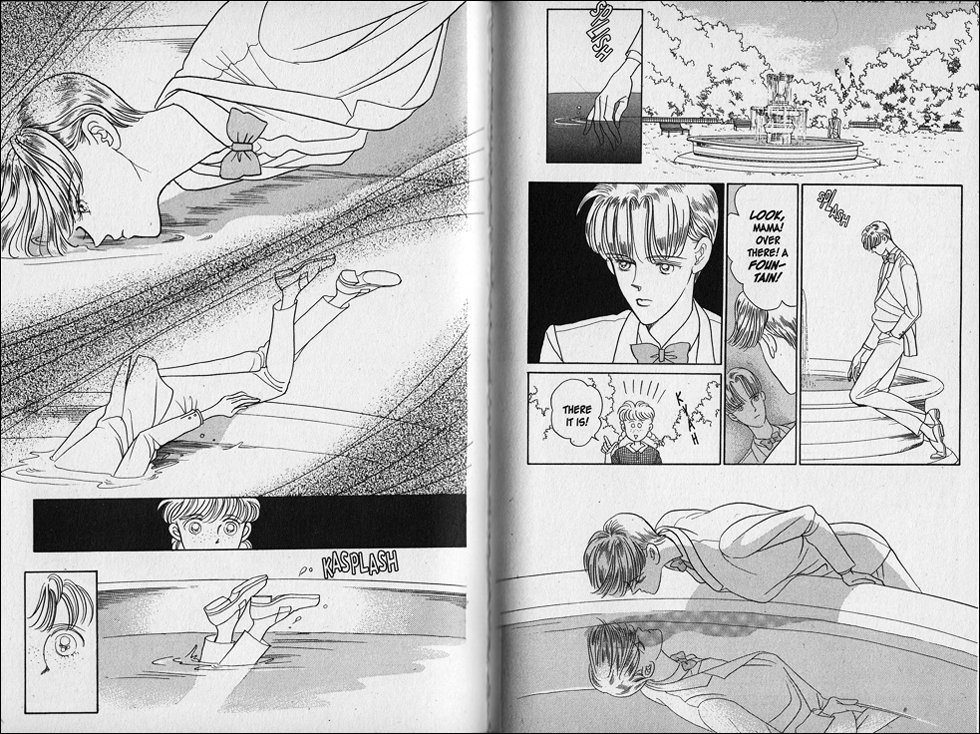
First, of course, there is quite a bit of objectively lovely imagery in the later panels of the scene, including rippling water, a flowing seascape, and a billowy-haired mermaid, all rendered with a perfect balance of simplicity and detail. I’m particularly fond of Shimizu’s style of character design as well, which is very much in step with most of the ’80s and early ’90s manga I’ve read. For whatever reason, this is probably my very favorite period for shoujo character design.
Most of all, though, there is an eerie, vaguely melancholy tone throughout the entire scene, particularly the first two pages, which I will admit are my favorite. I even consider them the prettiest of the whole sequence, though they have none of the flowing seascape that decorates the rest of the scene. They are, however, beautifully strange, and a perfect example of what I personally find prettiest in shoujo manga. This may seem like an odd thing to say, but I find the strangeness—this particular brand of strangeness—to be really, really beautiful. When I look at the first two pages of this sequence, I can feel the smooth surface of the water as the character brings his face near, touching the ends of his hair and the tips of his nose and chin. That smooth pool of water and the way he just falls slowly into it—it’s difficult for me to articulate exactly why I find it beautiful, but I really do.
Yes, I love these character designs, and the pretty page layouts, but sometimes what I find most beautiful about older shoujo manga is its strangeness. It brings to mind a dreamworld, I guess—one that looks like our world but somehow just isn’t in a way that engages the most obscure, most beloved corners of my imagination. These stories make themselves part of my private world, and I find them beautiful for it. If that makes any sense at all.
MICHELLE: It absolutely makes sense. And for what it’s worth, I studied the pages before I read your commentary and also felt that the exquisitely slow descent into the fountain was the loveliest part. I like, too, how Teruto slips into the fountain with such grace and barely a ripple and how this is contrasted off-panel by the little girl who has observed what happened. The inability of an everyday person to access the same magic only reinforces its strangeness.
MJ: Yes, exactly! It seems so clear that he exists in a different state of being from the regular people around him, which is part of what makes it feel so dreamlike, I think. There is a lot of that kind of thing in this series, which is really, exquisitely strange. I think the dreamlike tone makes it easier to suspend disbelief as well.
MICHELLE: From the examples we’ve both chosen, it seems that, to some extent, it’s the dreaminess of pretty scenes that is at least partly responsible for the happy sighing. Of course, we realize that real life is seldom so lovely, but it’s nice to abandon oneself for a while in a reality where that sort of thing really can happen.
MJ: I think where I often find solace in shoujo manga, is that it offers exactly what you describe—a reality that contains the stuff of dreams—but held together by real human feeling, such that even the wildest tale can often shine much-needed light on our real-life emotional turmoil. At the heart of all this strange, sparkly fantasy, there is a solid base of real emotional truth, which is sometimes easier to face when it’s presented in a pretty, dreamlike package.
MICHELLE: Well put! I think that’s one of the major strengths of genre fiction in general, actually, no matter the media.
MJ: Agreed! Of course, nothing does “pretty” quite like classic shoujo.
MICHELLE: Indeed not. That’s just icing on the cake!

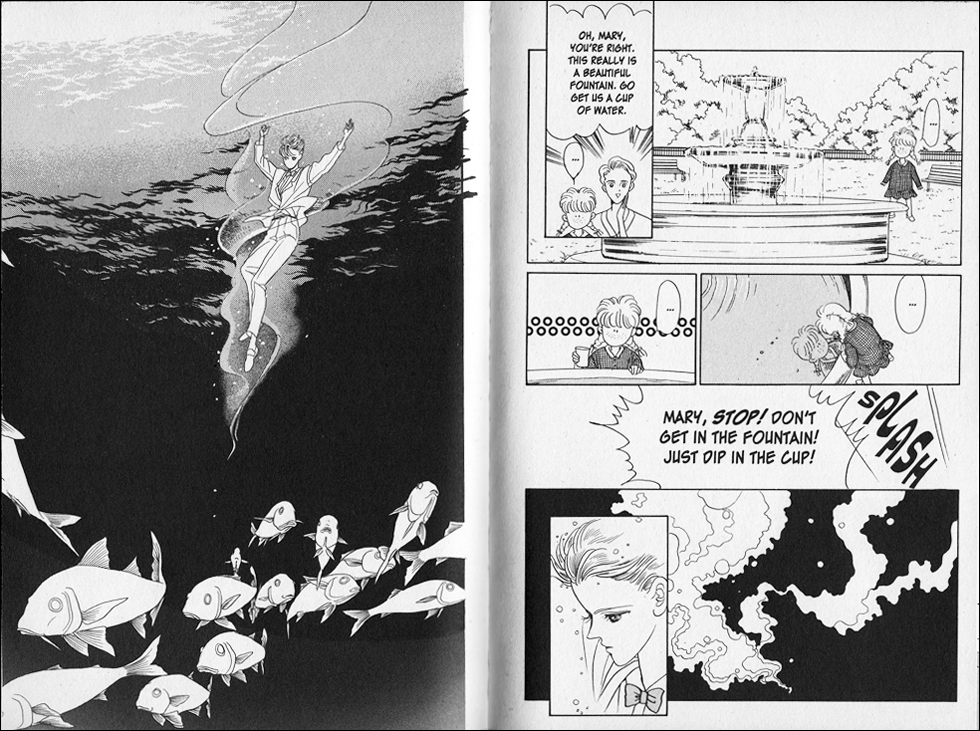
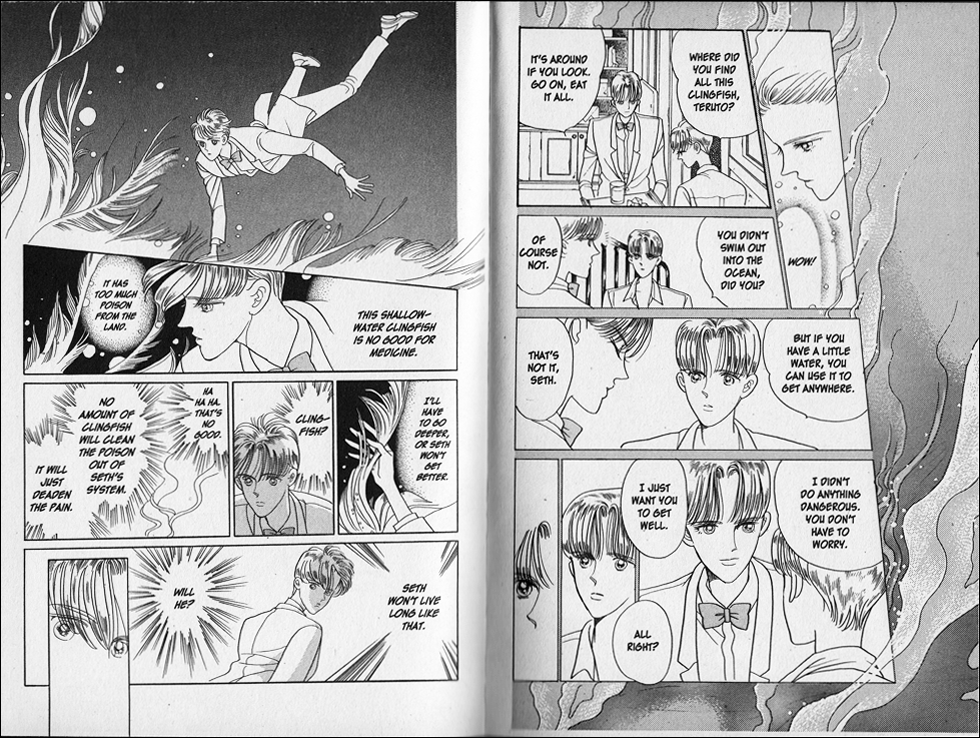




While I adore Sailormoon, I’m especially giddy to see Shimizu Reiko given a nod for her beautiful style. I’ve always enjoyed how skilled she is at creating the settings for her stories. Tsuki no Ko has a great mix of the modern world with fantastical mermaids and imagery. I wish her other sci-fi stories, particularly with her robots Jack and Elena, would get translated. Ryuu no Nemuru Hoshi in particular is amazing with its sci-fi, space-traveling setting, yet also has dinosaurs roaming a planet and a tribe of people who can breathe underwater… it all meshes together beautifully. Both Jack and Elena have somewhat simple, yet great character designs. She’s very talented and my favorite from “classic” shoujo… and I quite like her modern stuff as well!
Hi, and thanks for the comment! I, too, desperately wish for more Shimizu. The Jack and Elena stories are definitely appealing, though my most-wanted series is her josei title, Himitsu: The Top Secret. I’ve been working on acquiring Princesse Kaguya in French, and have now compiled all extant volumes, so it’s time to switch to acquiring Top Secret. Who knows when I’ll get around to reading them, but at least I’ll have them in some form.
Oh, I would love to see more Shimizu licensed, “classic” or not!
“I’m particularly fond of Shimizu’s style of character design as well, which is very much in step with most of the ’80s and early ’90s manga I’ve read. For whatever reason, this is probably my very favorite period for shoujo character design. ”
This is also my favourite periods in shojo manga art (though 70s comes really, really close), particularly on the 90s end of the spectrum. To be honest, I am acutally not particularly fond of the current art style in Japanese shojo – I much prefer current styles in sunnjeong manhwa.
If there would an upload image feature on this comment system, I would totally share some stuff that *I* think is pretty, because I think sharing the prettiness is the most appropriate way to respond to such a post *sigh* prettiness…
Hm. Well, you could upload them elsewhere and paste a bunch of URLs with commentary into the comment box. 🙂
flickr! flickr! 😀
That masquerade chapter from Sailormoon… ahhhh!! My original v1’s spine is cracked and the pages are falling out right at that page spread. I read that scene so many times 😀 Such pretty!! I always thought the lacy doily designs in Takeuchi-sensei’s manga were done with an actual airbrush rather than a placed screentone. I don’t know for sure, but they do have a really tangible quality, as does the sort of white-speckled-ness she uses for starry skies (and dramatic effect). I still half-consciously model starry skies in my own illustration work after hers. (and I still save paper doilies, thinking, “someday I’ll make my own airbrushed lacy pictures!”)
And Reiko Shimizu!! I can never thank CMX enough for some of their series. I really enjoyed your look at and analysis of those pages. She seems especially great (within the scope of things I’ve read/seen) at that sense of dreamy strange-beauty. And I agree with Melinda about 80s and early 90s being a great period of shoujo art (though I love the fashion sense on display in 70s manga). I think almost all my favourite artists started around then, and I love how something of that quality comes through even in their modern work (I’m thinking of Saki Hiwatari, Miyuki Yamaguchi, Nanpei Yamada, Taeko Watanabe, Marimo Ragawa…).
You may be right about the airbrush, assuming you mean kind of like a stenciling effect or something. It does look different than normal screentone, at any rate.
Not only do I probably like ’90s art the most, I also like ’90s anime the best, I think. I’ve tried to watch some recent things and “meh,” but show me Slam Dunk and suddenly it feels so cozy and nostalgic.
I was thinking about Saki Hiwatari, in particular, when I said that as well. I pondered pulling something from PSME for this column, but since Michelle & I have already discussed that series at length, I thought this might be more fun.